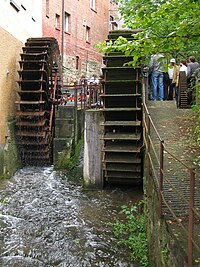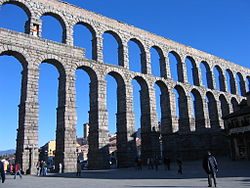Hydraulics



Hydraulics (from
Free surface hydraulics is the branch of hydraulics dealing with free surface flow, such as occurring in rivers, canals, lakes, estuaries and seas. Its sub-field open-channel flow studies the flow in open channels.
History
Ancient and medieval eras

Early uses of water power date back to Mesopotamia and ancient Egypt, where irrigation has been used since the 6th millennium BC and water clocks had been used since the early 2nd millennium BC. Other early examples of water power include the Qanat system in ancient Persia and the Turpan water system in ancient Central Asia.
Persian Empire and Urartu
In the
The Qanat spread to neighboring areas, including the Armenian highlands. There, starting in the early 8th century BC, the Kingdom of Urartu undertook significant hydraulic works, such as the Menua canal.[9][7][10]
The earliest evidence of water wheels and watermills date back to the ancient Near East in the 4th century BC,[11] specifically in the Persian Empire before 350 BCE, in the regions of Iraq, Iran,[12] and Egypt.[13]
China
In
Sri Lanka

In ancient Sri Lanka, hydraulics were widely used in the ancient kingdoms of Anuradhapura and Polonnaruwa.[16] The discovery of the principle of the valve tower, or valve pit, (Bisokotuwa in Sinhalese) for regulating the escape of water is credited to ingenuity more than 2,000 years ago.[17] By the first century AD, several large-scale irrigation works had been completed.[18] Macro- and micro-hydraulics to provide for domestic horticultural and agricultural needs, surface drainage and erosion control, ornamental and recreational water courses and retaining structures and also cooling systems were in place in Sigiriya, Sri Lanka. The coral on the massive rock at the site includes cisterns for collecting water. Large ancient reservoirs of Sri Lanka are Kalawewa (King Dhatusena), Parakrama Samudra (King Parakrama Bahu), Tisa Wewa (King Dutugamunu), Minneriya (King Mahasen)
Greco-Roman world
In Ancient Greece, the Greeks constructed sophisticated water and hydraulic power systems. An example is a construction by Eupalinos, under a public contract, of a watering channel for Samos, the Tunnel of Eupalinos. An early example of the usage of hydraulic wheel, probably the earliest in Europe, is the Perachora wheel (3rd century BC).[19]
In

In the Roman Empire, different hydraulic applications were developed, including public water supplies, innumerable aqueducts, power using watermills and hydraulic mining. They were among the first to make use of the siphon to carry water across valleys, and used hushing on a large scale to prospect for and then extract metal ores. They used lead widely in plumbing systems for domestic and public supply, such as feeding thermae.[citation needed]
Hydraulic mining was used in the gold-fields of northern Spain, which was conquered by
Arabic-Islamic world
In the
The earliest
Modern era (c. 1600–1870)
Benedetto Castelli and Italian Hydraulics
In 1619 Benedetto Castelli, a student of Galileo Galilei, published the book Della Misura dell'Acque Correnti or "On the Measurement of Running Waters," one of the foundations of modern hydrodynamics. He served as a chief consultant to the Pope on hydraulic projects, i.e., management of rivers in the Papal States, beginning in 1626.[31]
The science and engineering of water in Italy from 1500-1800 in books and manuscripts is presented in an illustrated catalog published in 2022. [32]
Blaise Pascal
Blaise Pascal (1623–1662) studied fluid hydrodynamics and hydrostatics, centered on the principles of hydraulic fluids. His discovery on the theory behind hydraulics led to his invention of the hydraulic press, which multiplied a smaller force acting on a smaller area into the application of a larger force totaled over a larger area, transmitted through the same pressure (or exact change of pressure) at both locations. Pascal's law or principle states that for an incompressible fluid at rest, the difference in pressure is proportional to the difference in height, and this difference remains the same whether or not the overall pressure of the fluid is changed by applying an external force. This implies that by increasing the pressure at any point in a confined fluid, there is an equal increase at every other end in the container, i.e., any change in pressure applied at any point of the liquid is transmitted undiminished throughout the fluids.
Jean Léonard Marie Poiseuille
A French physician, Poiseuille (1797–1869) researched the flow of blood through the body and discovered an important law governing the rate of flow with the diameter of the tube in which flow occurred.[33][citation needed]
In the UK
Several cities developed citywide
Hydraulic models
After students understand the basic principles of hydraulics, some teachers use a hydraulic analogy to help students learn other things. For example:
- The MONIAC Computeruses water flowing through hydraulic components to help students learn about economics.
- The thermal-hydraulic analogyuses hydraulic principles to help students learn about thermal circuits.
- The electronic–hydraulic analogy uses hydraulic principles to help students learn about electronics.
The conservation of mass requirement combined with fluid compressibility yields a fundamental relationship between pressure, fluid flow, and volumetric expansion, as shown below:[37]
Assuming an incompressible fluid or a "very large" ratio of compressibility to contained fluid volume, a finite rate of pressure rise requires that any net flow into the collected fluid volume create a volumetric change.
See also
Notes
- ISBN 978-4-254-26135-6.
- ^ Chisholm, Hugh, ed. (1911). . Encyclopædia Britannica. Vol. 14 (11th ed.). Cambridge University Press. p. 35.
- ^ "The Circulatory System: The Hydraulics of the Human Heart". 1 May 2017. Archived from the original on 1 May 2017. Retrieved 19 March 2019.
- PMID 24521101.
- ^ a b Centre, UNESCO World Heritage. "Shushtar Historical Hydraulic System". Whc.unesco.org. Retrieved 1 September 2018.
- ^ Goldsmith, Edward (2012). The qanats of Iran.
- ^ a b Lombard, Pierre (1991). "Du rythme naturel au rythme humain : vie et mort d'une technique traditionnelle, le qanat". MOM Éditions. 20 (1): 69–86.
- ^ "The qanats of Iran · Edward Goldsmith". archive.is. 14 April 2013. Archived from the original on 14 April 2013. Retrieved 1 September 2018.
- ISBN 978-2-85978-397-6.
- S2CID 131657710.
- ISBN 978-0-8018-7248-8, p. 14
- ISBN 978-94-017-1416-7.
- doi:10.3390/w7095031.
- )
- ^ "Armillary Sphere". Library of Congress. Retrieved 10 July 2022.
- ^ "SriLanka-A Country study" (PDF). USA Government, Department of Army. 1990. Archived from the original (PDF) on 5 September 2012. Retrieved 9 November 2011.
- ^ "SriLanka – History". Asian Studies Center, Michigan State University. Archived from the original on 28 December 2011. Retrieved 9 November 2011.
- ^ "Traditional SriLanka or Ceylon". Sam Houston State University. Archived from the original on 27 September 2011. Retrieved 9 November 2011.
- S2CID 129173283.
- ^ Museum, Victoria and Albert. "Catalogue of the mechanical engineering collection in the Science Division of the Victoria and Albert Museum, South Kensington, with descriptive and historical notes." Ulan Press. 2012.
- ^ Centre, UNESCO World Heritage. "Las Médulas". Whc.unesco.org. Retrieved 13 June 2017.
- ^ "Las Médulas". Castilla y León World Heritage UNESCO (in European Spanish). 30 October 2014. Retrieved 13 June 2017.
- ^ Ahmad Y. al-Hassan (1976). Taqi al-Din and Arabic Mechanical Engineering, pp. 34–35. Institute for the History of Arabic Science, University of Aleppo.
- ^ Maya Shatzmiller, p. 36.
- ^ Adam Robert Lucas (2005), "Industrial Milling in the Ancient and Medieval Worlds: A Survey of the Evidence for an Industrial Revolution in Medieval Europe," Technology and Culture 46 (1), pp. 1–30 [10].
- ^ Ahmad Y. al-Hassan, Transfer Of Islamic Technology To The West, Part II: Transmission Of Islamic Engineering Archived 18 February 2008 at the Wayback Machine
- ^ Al-Hassani, Salim (30 January 2008). "800 Years Later: In Memory of Al-Jazari, A Genius Mechanical Engineer". Muslim Heritage. The Foundation for Science, Technology, and Civilisation. Retrieved 30 April 2015.
- .
- ISSN 1355-7718.
- ^ Professor Noel Sharkey, A 13th Century Programmable Robot (Archive), University of Sheffield.
- ^ "The Galileo Project – Science – Benedetto Castelli". Galileo.rice.edu.
- ^ Andrews, Mark E. 2022. The Science and Engineering of Water: An Illustrated Catalogue of Books and Manuscripts on Italian Hydraulics 1500-1800. Toronto: AE Publications.
- ^ Sutera and Skalak, Salvatore and Richard. The History of Poiseuille's Law. Annu. Rev. Fluid Mech. 1993. 25: 1-19.
- ^ "Joseph Bramah". Robinsonlibrary.com. 23 March 2014. Archived from the original on 24 October 2006. Retrieved 8 April 2014.
{{cite web}}: CS1 maint: unfit URL (link) - ^ "William George Armstrong, Baron Armstrong of Cragside (1810-1900)". Victorianweb.org. 22 December 2005. Retrieved 8 April 2014.
- ^ "Subterranea Britannica: Sites: Hydraulic power in London". Subbrit.org.uk. 25 September 1981. Retrieved 8 April 2014.
- ^ "Archived copy" (PDF). Archived from the original (PDF) on 23 April 2018. Retrieved 23 April 2018.
{{cite web}}: CS1 maint: archived copy as title (link)
References
- Rāshid, Rushdī; Morelon, Régis (1996), Encyclopedia of the history of Arabic science, London: Routledge, ISBN 978-0-415-12410-2.

